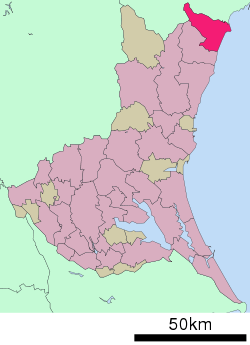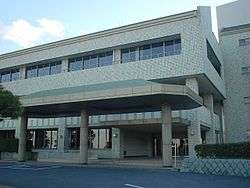Kitaibaraki, Ibaraki
| Kitaibaraki 北茨城市 | |||
|---|---|---|---|
| City | |||
|
Kitaibaraki city hall | |||
| |||
 Location of Kitaibaraki in Ibaraki Prefecture | |||
 Kitaibaraki
| |||
| Coordinates: 36°48′6.8″N 140°45′3.7″E / 36.801889°N 140.751028°ECoordinates: 36°48′6.8″N 140°45′3.7″E / 36.801889°N 140.751028°E | |||
| Country | Japan | ||
| Region | Kantō | ||
| Prefecture | Ibaraki Prefecture | ||
| Area | |||
| • Total | 186.80 km2 (72.12 sq mi) | ||
| Population (September 2015) | |||
| • Total | 43,809 | ||
| • Density | 235/km2 (610/sq mi) | ||
| Time zone | Japan Standard Time (UTC+9) | ||
| - Tree | Pine | ||
| - Flower | Rhododendron ponticum | ||
| - Bird | Common gull | ||
| - Fish | Goosefish | ||
| Phone number | 0293-43-1111 | ||
| Address | Isohara 1630, Isohara-chō, Kitaibaraki-shi, Ibaraki-ken 319-1592 | ||
| Website | Official website | ||
Kitaibaraki (北茨城市 Kitaibaraki-shi) is a city located in Ibaraki Prefecture, in the northern Kantō region of Japan. As of September 2015, the city had an estimated population of 43,809 and a population density of 235 persons per km². Its total area was 186.80 square kilometres (72.12 sq mi).
Geography
Kitaibaraki is located in northern Ibaraki Prefecture, bounded by Fukushima Prefecture to the north and the Pacific Ocean to the east. As its name implies, it is the northernmost city within Ibaraki. Approximately 80% of the total area is mountainous forest. The eastern region is low ground facing the ocean with spacious open flatland along the Okita and Satone Rivers. It is approximately 57 kilometers to the northeast of Mito, the prefectural capital.
Surrounding municipalities
- Ibaraki Prefecture
- Fukushima Prefecture
History
The towns of Otsu and Hiragata and the village of Kitanakago were created with the establishment of the municipalities system on April 1, 1889. Kitanakago became the town of Isohara on January 1, 1925. On March 31, 1956 the towns of Otsu, Hiragata, Isohara and the villages of Sekinan, Sekimonto and Minaminakago merged to form the city of Kitaibaraki. The city suffered from serious damage caused by the tsunami from the 2011 Tōhoku earthquake.[1]
Economy
Commerce developed during the Edo period along the Tanagura highway, which was also called the 'Road of Salt'. The area flourished with ports for water transportation and coal mining began at the end of the Edo period. Kitaibaraki is now a regional commercial center with some light manufacturing. The Joban Coal Field, which was the mainstay of the economy from the Meiji period to the mid-Showa period, closed in 1976. Commercial fishing from Otsu fishing port, notably for angler fish is also a factor in the local economy.
Education
Kitaibaraki has 12 elementary schools, five middle schools, and one high school.
Transportation
Railway
- JR East – Jōban Line
- * Minami-Nakagō - Isohara - Ōtsukō.
Highway
- Jōban Expressway – Kitaibaraki IC, Nakago SA, Sekimoto PA
- Japan National Route 6
Sister city relations
Local attractions
- The scenic Istuura coastline is near Otsu fishing port. This area was famous for Rokkaku-do, a six sided red house built by Tenshin Okakura. The Tenshin Memorial Museum, with regularly updated exhibits, offers visitors a glance at various schools of Japanese art. The sound of the waves of the Itsuura coast are listed as one of the 100 Soundscapes of Japan by the Japanese Ministry of the Environment [3]
- Ujō Noguchi Memorial Museum
Festivals
- The Sasara of Hanazono Shrine is a Shishi Mai (ritual dance with a lion's mask) with a 900 year-tradition. This dance can be seen yearly on May 5 at the Hanazono Shrine.
- The Ofuna-Matsuri, the seafarer's festival, is held only once every five years. The first weekend in May, the festival is a prayer for large fish catches and protection from the clutches of the sea. A decorated ship is pulled by the seamen through the town toward a Shinto shrine. It was last held in 2014.
- August 16 is the last day of Obon (festival of the dead). On this day around 6 AM, families celebrating Obon gather at Otsu Port for Bonbune Nagashi. Miniature fishing boats laden with vegetables are paraded in the port, and afterwards lanterns are let out to see in order to guide home the spirits of the dead.
- The Kitaibaraki Citizen's Festival is held yearly on the last Saturday of August. There is a dance contest and fireworks.
- The 'Ujo no Sato Minato Matsuri' (port festival) is held in the beginning of November at Otsu Port. There are various cultural exhibits along with food and game stalls. There is also a demonstration of how to carve an angler fish.
Notable people from Kitaibaraki
- Ujō Noguchi – poet, songwriter
- Atsuko Kurusu – actress
- Takehito Kanazawa – professional baseball player
References
- ↑ http://www.comcast.net/slideshow/news-toppix0307/8/ Kita Ibaraki
- ↑ "Sister Cities & Friendship cities located in the upper half of the North Island". Sister cities. Consulate-General of Japan in Auckland. Retrieved 7 December 2015.
- ↑ "100 Soundscapes of Japan". Ministry of the Environment. Retrieved 18 April 2011. (Japanese)
External links
| Wikimedia Commons has media related to Kitaibaraki, Ibaraki. |
- Official website (Japanese)

